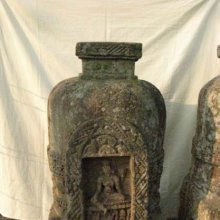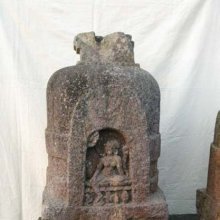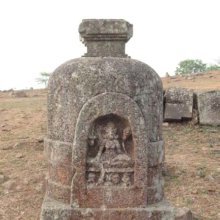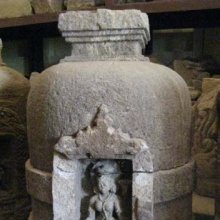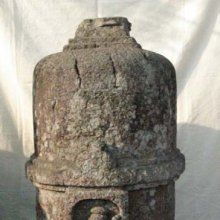Atara, Aṭārā, Ātara, Ātāra: 12 definitions
Introduction:
Atara means something in Hinduism, Sanskrit, Marathi, Jainism, Prakrit. If you want to know the exact meaning, history, etymology or English translation of this term then check out the descriptions on this page. Add your comment or reference to a book if you want to contribute to this summary article.
Images (photo gallery)
(+28 more images available)
Languages of India and abroad
Marathi-English dictionary
Source: DDSA: The Molesworth Marathi and English Dictionaryaṭārā (अटारा).—m (aṭaṇēṃ or aṭa) Working (a man or beast) hard; knocking up by hard working. v pāḍa g. of o. paḍa g. of s.
--- OR ---
atāra (अतार) [or री, rī].—m (Better attārā) A vender of ottar of roses &c.
Source: DDSA: The Aryabhusan school dictionary, Marathi-Englishatāra (अतार) [-rī, -री].—m A vendor of attara. Perfumer.
Marathi is an Indo-European language having over 70 million native speakers people in (predominantly) Maharashtra India. Marathi, like many other Indo-Aryan languages, evolved from early forms of Prakrit, which itself is a subset of Sanskrit, one of the most ancient languages of the world.
Sanskrit dictionary
Source: DDSA: The practical Sanskrit-English dictionaryĀtara (आतर) or Ātāra (आतार).—[ātarati anena ātṛ ap-ghañ-vā]
1) Fare for being ferried over a river, passage-money, freight.
2) Distance to be crossed by a boat &c; आतरलाघवहेतो- र्मुरहर तरणिं तवालम्बे (ātaralāghavaheto- rmurahara taraṇiṃ tavālambe) | Udb.
Derivable forms: ātaraḥ (आतरः), ātāraḥ (आतारः).
Source: Cologne Digital Sanskrit Dictionaries: Edgerton Buddhist Hybrid Sanskrit DictionaryAtara (अतर).—m. (compare next), a high number: Mahāvyutpatti 7777 (°raḥ); Gaṇḍavyūha 106.14 (°rasya).
Source: Cologne Digital Sanskrit Dictionaries: Shabda-Sagara Sanskrit-English DictionaryĀtara (आतर).—m.
(-raḥ) Fare, freight. E. āṅ, tṛ to cross or pass over, ap aff.
--- OR ---
Ātāra (आतार).—m.
(-raḥ) Fare, freight. E. āṅ, tṛ to cross, affix ghañ.
Source: Cologne Digital Sanskrit Dictionaries: Monier-Williams Sanskrit-English Dictionary1) Atara (अतर):—[=a-tara] mfn., ‘impassable’
2) Ātara (आतर):—[=ā-tara] a etc. See ā-√tṝ.
3) Ātāra (आतार):—[=ā-tāra] a and ā-tārya See ā-√tṝ.
4) Ātara (आतर):—[=ā-tara] [from ā-tṝ] b m. crossing over a river, [Rājataraṅgiṇī]
5) [v.s. ...] fare for being ferried over a river, Śukasaṃdeśa 10 [Buddhist literature]
6) Ātāra (आतार):—[=ā-tāra] [from ā-tṝ] b m. (= ā-tara) fare, [cf. Lexicographers, esp. such as amarasiṃha, halāyudha, hemacandra, etc.]
Source: Cologne Digital Sanskrit Dictionaries: Yates Sanskrit-English Dictionary1) Ātara (आतर):—[ā-tara] (raḥ) 1. m. Fare.
2) Ātāra (आतार):—[ā-tāra] (raḥ) 1. m. Fare.
Source: DDSA: Paia-sadda-mahannavo; a comprehensive Prakrit Hindi dictionary (S)Atara (अतर) in the Sanskrit language is related to the Prakrit words: Aira, Atāra, Ayara.
[Sanskrit to German]
Sanskrit, also spelled संस्कृतम् (saṃskṛtam), is an ancient language of India commonly seen as the grandmother of the Indo-European language family (even English!). Closely allied with Prakrit and Pali, Sanskrit is more exhaustive in both grammar and terms and has the most extensive collection of literature in the world, greatly surpassing its sister-languages Greek and Latin.
Prakrit-English dictionary
Source: DDSA: Paia-sadda-mahannavo; a comprehensive Prakrit Hindi dictionaryAtāra (अतार) in the Prakrit language is related to the Sanskrit word: Atāra.
Prakrit is an ancient language closely associated with both Pali and Sanskrit. Jain literature is often composed in this language or sub-dialects, such as the Agamas and their commentaries which are written in Ardhamagadhi and Maharashtri Prakrit. The earliest extant texts can be dated to as early as the 4th century BCE although core portions might be older.
Kannada-English dictionary
Source: Alar: Kannada-English corpusĀtara (ಆತರ):—
1) [noun] a crossing of a river; ferrying.
2) [noun] the fare paid or to be paid for ferrying.
3) [noun] a boat, raft or a ferry used for carrying people, animals or goods across a river.
Kannada is a Dravidian language (as opposed to the Indo-European language family) mainly spoken in the southwestern region of India.
See also (Relevant definitions)
Starts with (+10): Atara Bhara Vanaspati, Atara Padma Vanarem, Ataracatti, Ataracilai, Atarage, Atarakkampi, Atarakkovai, Ataralakkanai, Ataralappu, Ataram, Ataramana, Ataranai, Atarancey, Ataranda Mahabhodikkhandha, Ataranem, Ataranga, Atarangatama, Ataranilai, Ataraniyaprakarana, Atarapanyena.
Ends with (+510): Abbhratara, Abhidhammavatara, Abhikkantatara, Abhinnatara, Adamhatara, Adatara, Addatara, Adhikatara, Agadhatara, Aghoraghoratara, Agnimatara, Agvavatara, Akashamatara, Akatara, Alabhyatara, Alakatara, Alamkaravatara, Alpatara, Amandatara, Amshavatara.
Full-text (+4): Aira, Ataram, Ayara, Atarapitam, Shatataram, Ataratantam, Atarakkampi, Ataranilai, Tatakavataram, Ataracatti, Anutara, Arru-kalataram, Atarya, Ataracilai, Atarapanyena, Amejataram, Ataralakkanai, Gamvara, Pinnataram, Datarac.
Relevant text
Search found 6 books and stories containing Atara, Aṭārā, Atāra, Ātara, Ātāra, A-tara, Ā-tara, Ā-tāra; (plurals include: Ataras, Aṭārās, Atāras, Ātaras, Ātāras, taras, tāras). You can also click to the full overview containing English textual excerpts. Below are direct links for the most relevant articles:
Amarakoshodghatana of Kshirasvamin (study) (by A. Yamuna Devi)
Economics (5): Means of Transportation < [Chapter 3 - Social Aspects]
Rig Veda (translation and commentary) (by H. H. Wilson)
Buddhist Monastic Discipline (by Jotiya Dhirasekera)
The Agni Purana (by N. Gangadharan)
A Blessed Pilgrimage (by Dr. Yutang Lin)
The gods of northern Buddhism (by Alice Getty)
